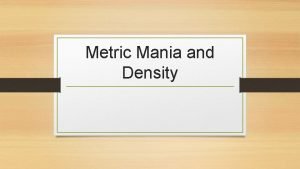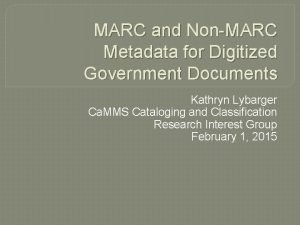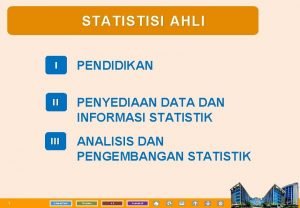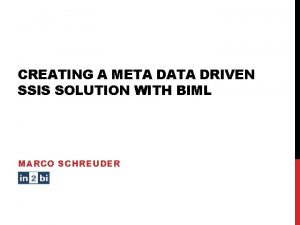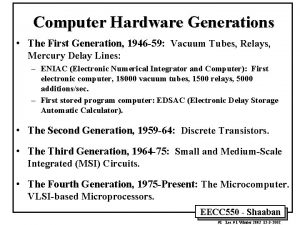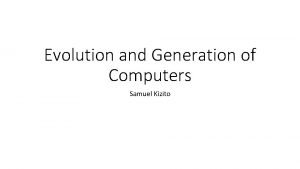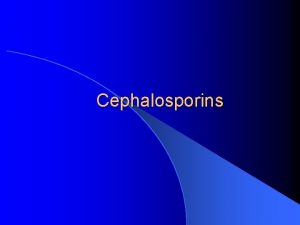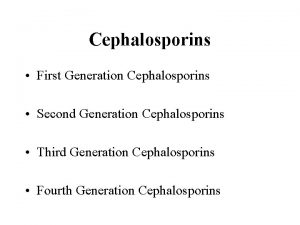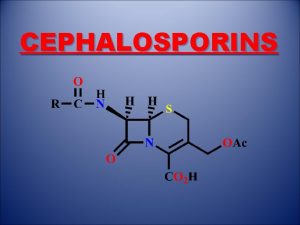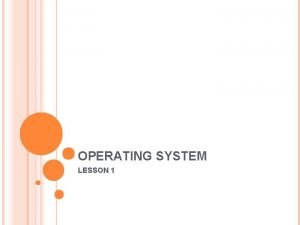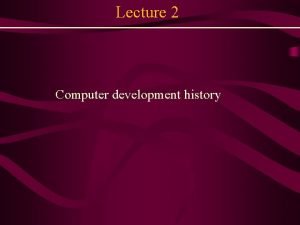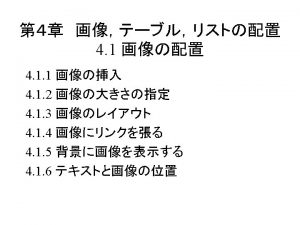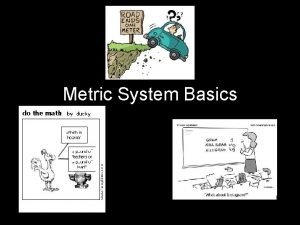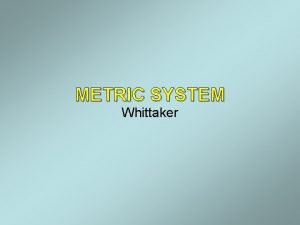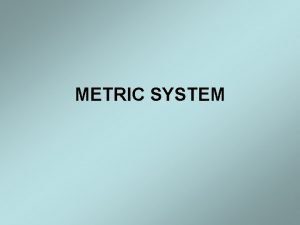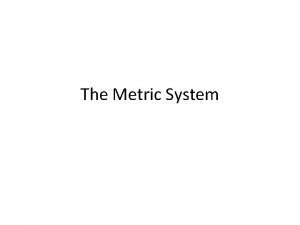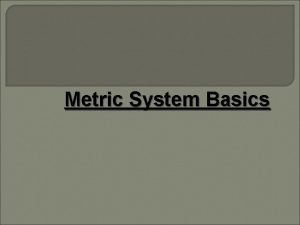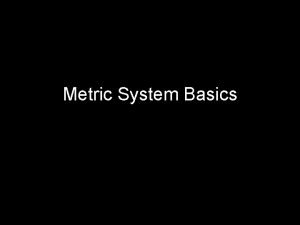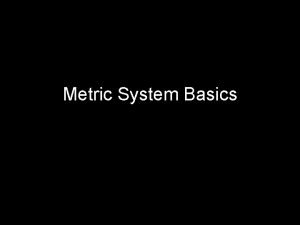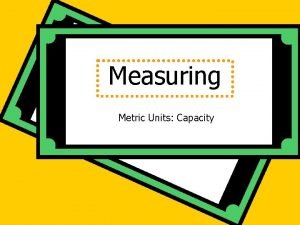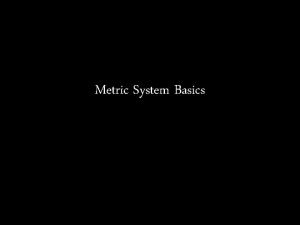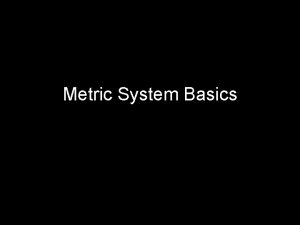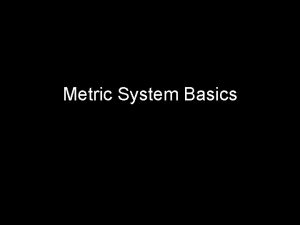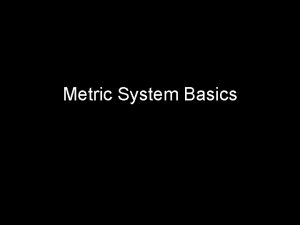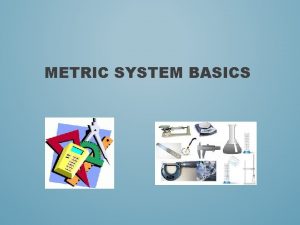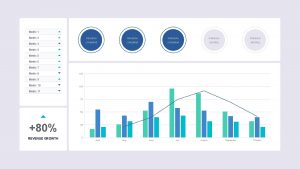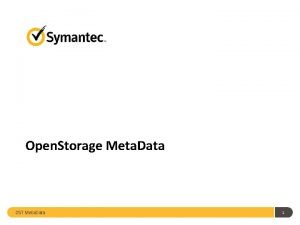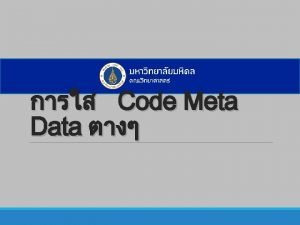Meta Analysis First Steps Data Analysis Metric Generation
























- Slides: 24

Meta Analysis First Steps Data Analysis, Metric Generation and Extracted Pattern Annotation

Project Goals for Meta-Analysis • Subgoal #1: Complete first statistical meta-analysis of ERP patterns from NEMO consortium datasets – Target first paper submission by May 2009 • Subgoal #2: Compare pattern mappings from different meta-analyses & establish functionally relevant links between patterns – Lexical, semantic, & memory-related ERP – Establish meaningful pattern classes, hierarchies based on meta analyses results

Meta Summary of ERP Data Meta Analysis Analyze Mark-up Label Cluster Link Label Linked Clusters Publish (rinse and repeat)

Meta Analysis Steps • Obtain ERP data sets with compatible functional constraints – NEMO consortium data • Decompose / segment the ERP data into discrete spatio-temporal patterns – PCA / ICA / Microstate Segmentation • Mark-up patterns with their categorical, functional and spatio-temporal characteristics – NEMOautolabel • Label patterns • Cluster patterns within data sets • Link labeled clusters across data sets • Label linked clusters • Publish

Datasets for Meta-analysis #1

Datasets for Meta-analysis #2 & #3

Techniques for Decomposing / Segmenting ERP Data Into Discrete Spatio-Temporal Patterns • Component Separation – PCA: Principal Components Analysis • Established protocol with supporting literature – Dien, Frishkoff, Kayser & Tenke • Applied to 9 consortium data sets from 3 separate labs – ICA: Independent Components Analysis • Established protocol with supporting literature, though less extensive than PCA ERP research – Makeig et al • Mixed results / interpretation difficulties w. r. t. consortium data • Automated Windowing / Microstate Segmentation • Established protocol with supporting literature – Lehman, Koenig, Murray • In progress: currently adding to NEMOautolabel

Microstate Segmentation Overview Simulated Microstates • Simulated data set of 4 distinct, finite duration, topographies (microstates). Note topographies are partially overlapping

Microstate Segmentation Overview Microstate Boundaries • Microstate border probability function (MSBPF): Quantifies probability of topographic change as a function of time

Overview of PCA • Temporal PCA – Variables: Time samples – Observations: Channel waveforms across conditons + subjects – Relationship matrix quantifies temporal correlations Basis of approach for decomposing and statistically quantifying NEMO consortium data • Spatial PCA – – Variables: Channel locations Observations: Spatial topographies across conditons + subjects Relationship matrix quantifies spatial correlations Problematic due to high spatial overlap of patterns from volume conduction Not used due to concerns of misallocation of variance / factor splitting

PCA Decomposition Protocol for Analysis of Consortium Data • Dien PCA Toolbox / ERP Toolkit • Read. Seg. Raw / PCAto. Raw to import from and export to EGI segmented simple-binary files • Temporal PCA algorithms – – – Covariance relationship matrix Kaiser factor loading normalization Retain all factors prior to any and all rotations Varimax rotation followed by Promax relaxation Statistically analyze 25 post-rotation factors, sorted in order of decreasing projected variance (based on Fac. Var)

PCAto. Raw / ERP PCA Toolbox • PCAto. Raw run-time parameters • PCAto. Raw invokes Dien ERP PCA Toolbox

PCAto. Raw / ERP PCA Toolbox • Npraw data PCA decomposition summary

PCA Decomposition Protocol Factor Retention – Part I • Pre-rotation factor retention – “The problem of the number of components” • Scree test – Linear scale may underestimate factor retention • Parallel test – Compare scree of experimental data to scree of random data of equal dimensions • Full pre-rotation retention – Kayser & Tenke proposal – Factor retention, pre-rotation, affects both explained variance and rotation outcome – Full pre-rotation retention eliminates effect of retention subjectivity on rotation outcome

PCA Decomposition Protocol Factor Retention – Part 2 • Post-rotation factor retention – Determine number of retained components for adequate reconstruction of scalp recorded ERP • Retained components represent majority of ERP variance – Factors are sorted on Fac. Var, the fraction of data variance accounted for by each individual factor – Default post-rotation sort order of ERP PCA Toolkit – Statistical analysis, via NEMOautolabel, performed on retained factors – Flag retained factors with “robust” variance or high relative Global Field Power – Flag retained factors containing spatiotemporal characteristics of target patterns

PCAto. Raw / ERP PCA Toolbox NPraw. raw Test Dataset Results • PCAto. Raw output files: –. log: –. mat: –. fig: –. raw: Summary run statistics MATLAB workspace variables Pre- and post-rotation factor scree plots Factor loadings projected back to channel space § One set for each conditon / cell § Grand average (_G. raw) or subject-specific (_S##. raw)

PCAto. Raw / ERP PCA Toolbox NPraw. raw Test Dataset Results • Examine NPraw_G. raw factor waveforms, in scalp-surface space, at each channel across conditions (Topo. Plot Mode) Factor 1 waveforms (0 -900 ms; 0. 1 uv/mm). Note condition effects / factor separation at centropariertal and anterior ventral sites

PCAto. Raw / ERP PCA Toolbox NPraw. raw Test Dataset Results • Examine NPraw_G. raw factor topographies, in scalp-surface space, at peak intensity across conditions (Topo. Map Mode) Factor 1 scalp-surface topographies, 600 ms post-stimulus, for the 4 NPraw experimental conditions (L to R): Con. Final, Con. Mid, Incon. Final, Incon. Mid

NEMOautolabel Marking up ERP Components / Microstates: NEMO_data • • Mark-up observed patterns (components / microstates) with user-specified information on the experimental procedure and subject group Each mark-up element (NEMOautolabel) has a unique NEMOautolabel ID and will map to a corresponding element in the NEMO ontology ERP_Comp. Analysis. Method Cond_Stan Expt. ID EEG_Montage Event_Modality Sess. ID Event_Type Cell. No Stim_Type Cell. Label ERP_Obs. ID Subject_Group ERP_Observed. Pattern NEMOautolabel_Name NEMOautolabel_Def NEMOautolabel_ID NEMOlex_Name NEMOlex_ID Expt. ID represents "experiment ID" and specifies the experimental procedure and subject group. AL: 0000003 experiment_id NM: 0000059

NEMOautolabel Marking up ERP Components / Microstates: NEMO_data • • Mark-up observed patterns (components / microstates) with their temporal characteristics MATLAB-based functions extract temporal metrics for each condition, subject and component / microstate – Data driven – Harnesses expert-knowledge: Domain experts specify the temporal characteristics of interest Ti_Max_round TI_Begin TI_End TI_Dur_round NEMOautolabel_Name NEMOautolabel_Def NEMOautolabel_ID NEMOlex_Name NEMOlex_ID Ti_Max specifies for each temporal component the time point of its peak absolute intensity, in milliseconds. AL: 0000019 ERP_pattern_peak_latency NM: 0000047

NEMOautolabel Marking up ERP Components / Microstates: NEMO_data • • Mark-up observed patterns (components / microstates) with their spatial characteristics MATLAB-based functions extract spatial metrics for each condition, subject and component / microstate – Data driven – Harnesses expert-knowledge: Domain experts specify the spatial characteristics of interest COP_X 2 d Lat. Index_Threshold EGICh_COP COP_Y 2 d Laterality_COP ITTCh_COP CON_X 2 d Lat. Index_COP ROI_COP CON_Y 2 d ROInolat_COP EGICh_CON COP_X 3 d Laterality_CON ITTCh_CON COP_Y 3 d Lat. Index _CON ROI_CON COP_Z 3 d ROInolat_CON CON_X 3 d CON_Y 3 d CON_Z 3 d NEMOautolabel_Name NEMOautolabel_Def NEMOautolabel_ID NEMOlex_Name NEMOlex_ID ITTCh_COP International 10 -10 electrode location closest to the component pair's center-ofpositivity xy-coordinate pair (COP_X 2 d, COP_Y 2 d), in L 2 norm, on a montage-specific 2 -D flat map of scalp-surface electrode locations. AL: 0000036 TBA

References PCA Dien, J. (1998). Addressing misallocation of variance in principal components analysis of event-related potentials. Brain Topogr, 11(1), 43 -55. Dien, J. , & Frishkoff, G. A. (2005). Introduction to principal components analysis of event-related potentials. In T. Handy (Ed. ), Event-Related Potentials: A Methods Handbook. (pp. 189 -208). Cambridge, MA: MIT Press. Dien, J. , Beal, D. J. , & Berg, P. (2005). Optimizing principal components analysis of event-related potentials: matrix type, factor loading weighting, extraction, and rotations. Clin Neurophysiol, 116(8), 1808 -1825. Dien, J. (2006). Progressing towards a consensus on PCA of ERPs. Clin Neurophysiol, 117(3), 699 -702; author reply 703 -697. Dien, J. , Khoe, W. , & Mangun, G. R. (2007). Evaluation of PCA and ICA of simulated ERPs: Promax vs. Infomax rotations. Hum Brain Mapp, 28(8), 742 -763. Dien, J. (2009). Evaluating two-step PCA of ERP data with Geomin, Infomax, Oblimin, Promax, and Varimax rotations. Psychophysiology. Kayser, J. , & Tenke, C. E. (2003). Optimizing PCA methodology for ERP component identification and measurement: theoretical rationale and empirical evaluation. Clin Neurophysiol, 114(12), 2307 -2325. Kayser, J. , & Tenke, C. E. (2005). Trusting in or breaking with convention: towards a renaissance of principal components analysis in electrophysiology. Clin Neurophysiol, 116(8), 1747 -1753.

References ICA Dien, J. , Khoe, W. , & Mangun, G. R. (2007). Evaluation of PCA and ICA of simulated ERPs: Promax vs. Infomax rotations. Hum Brain Mapp, 28(8), 742 -763. Microstate Analysis Michel, C. M. , Murray, M. M. , Lantz, G. , Gonzalez, S. , Spinelli, L. , & Grave de Peralta, R. (2004). EEG source imaging. Clin Neurophysiol, 115(10), 2195 -2222. Murray, M. M. , Brunet, D. , & Michel, C. M. (2008). Topographic ERP analyses: a step-by-step tutorial review. Brain Topogr, 20(4), 249 -264. Koenig, T. , Kochi, K. , & Lehmann, D. (1998). Event-related electric microstates of the brain differ between words with visual and abstract meaning. Electroencephalogr Clin Neurophysiol, 106(6), 535 -546. Koenig, T. , & Lehmann, D. (1996). Microstates in language-related brain potential maps show noun-verb differences. Brain Lang, 53(2), 169 -182. Lehman, D. , & Skrandies, W. (1985). Spatial analysis of evoked potentials in man - A review. Progress in Neurobiology, 23, 227 -250. Pizzagalli, D. , Lehmann, D. , Koenig, T. , Regard, M. , & Pascual-Marqui, R. D. (2000). Face-elicited ERPs and affective attitude: brain electric microstate and tomography analyses. Clin Neurophysiol, 111(3), 521 -531.

References Annotating functional attributes Fox, P. T. , Laird, A. R. , Fox, S. P. , Fox, P. M. , Uecker, A. M. , Crank, M. , et al. (2005). Brain. Map taxonomy of experimental design: description and evaluation. Hum Brain Mapp, 25(1), 185 -198. Spatial & temporal metric generation Handy, T. (2005). Basic Principles of ERP Quantification. In T. Handy (Ed. ), Event-Related Potentials: A Methods Handbook (pp. 33– 56). Cambridge, MA: MIT Press. Luck, S. (2005). An Introduction to the Event-Related Potential Technique Boston, MA: The MIT Press. Otten, L. J. , & Rugg, M. D. (2005). Interpreting Event-Related Brain Potentials. In T. Handy (Ed. ), Event. Related Potentials: A Methods Handbook (pp. 3– 16). Cambridge, MA: MIT Press. Picton, T. W. , Bentin, S. , Berg, P. , Donchin, E. , Hillyard, S. A. , Johnson, R. , Jr. , et al. (2000). Guidelines for using human event-related potentials to study cognition: recording standards and publication criteria. Psychophysiology, 37(2), 127 -152.
 Meta sinclair
Meta sinclair Second generation vs first generation antipsychotics
Second generation vs first generation antipsychotics Metric mania
Metric mania God you are good and your mercy endureth forever
God you are good and your mercy endureth forever Metric unit ladder method
Metric unit ladder method Non-marc meta data
Non-marc meta data Contoh metadata
Contoh metadata Meta data driven
Meta data driven First generation consoles
First generation consoles First generation right
First generation right The five generations of computers
The five generations of computers Third generation computers advantages disadvantages
Third generation computers advantages disadvantages First generation evolution of hardware
First generation evolution of hardware First generation of rights
First generation of rights Third-generation cephalosporin
Third-generation cephalosporin Sulfonylurea moa
Sulfonylurea moa First generation of rights
First generation of rights Characteristics of first generation of computer
Characteristics of first generation of computer History of cephalosporins
History of cephalosporins First generation cephalosporin
First generation cephalosporin Cephalosporins1
Cephalosporins1 Financial aid algonquin college
Financial aid algonquin college First generation of operating system
First generation of operating system First generation of computer
First generation of computer Basic concepts of computer science
Basic concepts of computer science


